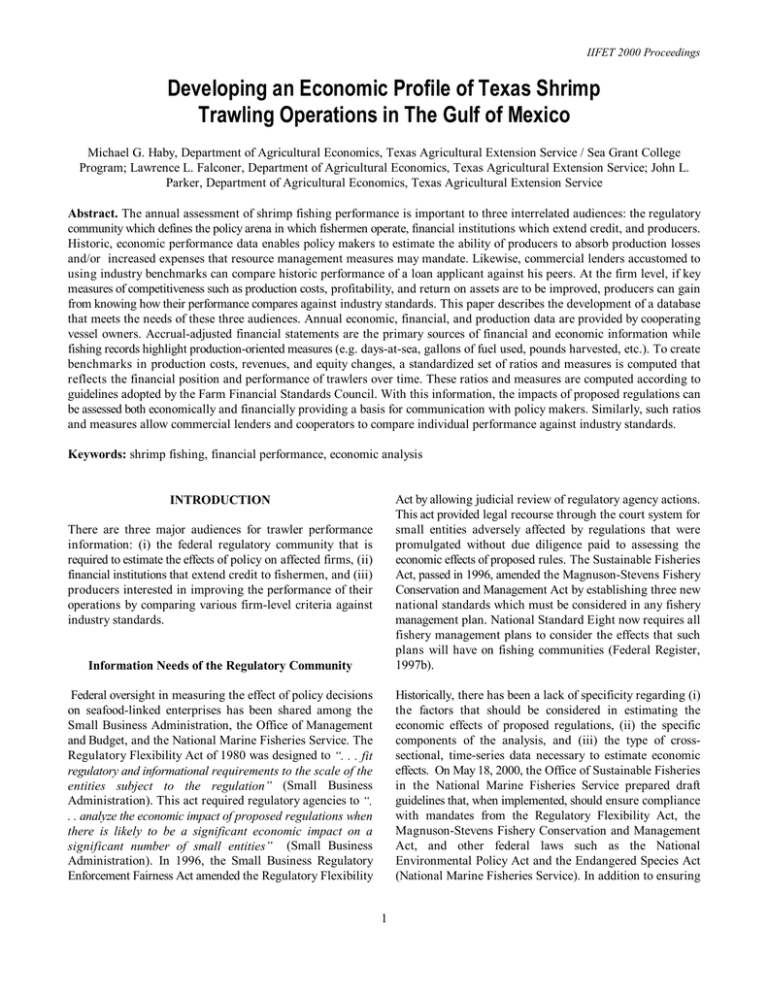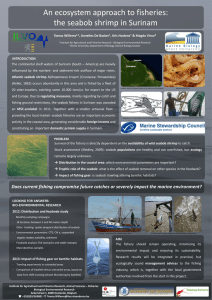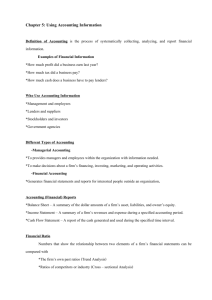Developing an Economic Profile of Texas Shrimp
advertisement

IIFET 2000 Proceedings Developing an Economic Profile of Texas Shrimp Trawling Operations in The Gulf of Mexico Michael G. Haby, Department of Agricultural Economics, Texas Agricultural Extension Service / Sea Grant College Program; Lawrence L. Falconer, Department of Agricultural Economics, Texas Agricultural Extension Service; John L. Parker, Department of Agricultural Economics, Texas Agricultural Extension Service Abstract. The annual assessment of shrimp fishing performance is important to three interrelated audiences: the regulatory community which defines the policy arena in which fishermen operate, financial institutions which extend credit, and producers. Historic, economic performance data enables policy makers to estimate the ability of producers to absorb production losses and/or increased expenses that resource management measures may mandate. Likewise, commercial lenders accustomed to using industry benchmarks can compare historic performance of a loan applicant against his peers. At the firm level, if key measures of competitiveness such as production costs, profitability, and return on assets are to be improved, producers can gain from knowing how their performance compares against industry standards. This paper describes the development of a database that meets the needs of these three audiences. Annual economic, financial, and production data are provided by cooperating vessel owners. Accrual-adjusted financial statements are the primary sources of financial and economic information while fishing records highlight production-oriented measures (e.g. days-at-sea, gallons of fuel used, pounds harvested, etc.). To create benchmarks in production costs, revenues, and equity changes, a standardized set of ratios and measures is computed that reflects the financial position and performance of trawlers over time. These ratios and measures are computed according to guidelines adopted by the Farm Financial Standards Council. With this information, the impacts of proposed regulations can be assessed both economically and financially providing a basis for communication with policy makers. Similarly, such ratios and measures allow commercial lenders and cooperators to compare individual performance against industry standards. Keywords: shrimp fishing, financial performance, economic analysis Information Needs of the Regulatory Community Act by allowing judicial review of regulatory agency actions. This act provided legal recourse through the court system for small entities adversely affected by regulations that were promulgated without due diligence paid to assessing the economic effects of proposed rules. The Sustainable Fisheries Act, passed in 1996, amended the Magnuson-Stevens Fishery Conservation and Management Act by establishing three new national standards which must be considered in any fishery management plan. National Standard Eight now requires all fishery management plans to consider the effects that such plans will have on fishing communities (Federal Register, 1997b). Federal oversight in measuring the effect of policy decisions on seafood-linked enterprises has been shared among the Small Business Administration, the Office of Management and Budget, and the National Marine Fisheries Service. The Regulatory Flexibility Act of 1980 was designed to “. . . fit regulatory and informational requirements to the scale of the entities subject to the regulation” (Small Business Administration). This act required regulatory agencies to “. . . analyze the economic impact of proposed regulations when there is likely to be a significant economic impact on a significant number of small entities” (Small Business Administration). In 1996, the Small Business Regulatory Enforcement Fairness Act amended the Regulatory Flexibility Historically, there has been a lack of specificity regarding (i) the factors that should be considered in estimating the economic effects of proposed regulations, (ii) the specific components of the analysis, and (iii) the type of crosssectional, time-series data necessary to estimate economic effects. On May 18, 2000, the Office of Sustainable Fisheries in the National Marine Fisheries Service prepared draft guidelines that, when implemented, should ensure compliance with mandates from the Regulatory Flexibility Act, the Magnuson-Stevens Fishery Conservation and Management Act, and other federal laws such as the National Environmental Policy Act and the Endangered Species Act (National Marine Fisheries Service). In addition to ensuring INTRODUCTION There are three major audiences for trawler performance information: (i) the federal regulatory community that is required to estimate the effects of policy on affected firms, (ii) financial institutions that extend credit to fishermen, and (iii) producers interested in improving the performance of their operations by comparing various firm-level criteria against industry standards. 1 IIFET 2000 Proceedings compliance with various federal statutes, these draft guidelines also enumerated a stepwise procedure for estimating the economic effects of fishery management plans. These guidelines highlighted four primary categories necessary to analyze regulatory impacts: (i) market-level changes (i.e., prices, quantities produced, etc.), (ii) changes in revenues and costs from fishing, (iii) changes in the size and composition of fishing fleets, and (iv) changes in the fish stock or stocks. The draft guidelines also suggested the data necessary to estimate expected impacts of policy options on fishing communities. These data include changes in harvesting costs, profitability, competitive position, productivity, and efficiency. substantially refurbish it. Few operators can afford to finance the replacement exclusively with retained earnings, so external credit must be obtained. Traditionally, lenders made loans based on the collateral offered and the borrower’s equity. Since the banking / savings and loan debacle in the mid-eighties, financial regulatory agencies have stressed performance-based lending. Performance-based lending stresses profitability and repayment capacity of the borrower as the primary criteria in deciding whether to extend credit. This requires an understanding of the borrower’s current financial position and anticipated future financial performance. One of the key references most lenders use in evaluating a specific loan application is an economic and financial profile of the prospective borrower’s industry. By comparing industry information to the borrower’s own financial statements and projections, lenders can determine the borrower’s relative position in his industry (i.e., “Is this borrower above or below the industry average?”). The availability of industry-wide financial information is important, because the loan applications of fishermen, farmers, and main-street businesses are all treated as commercial applications. Without industrywide performance standards, lenders could conclude that a prospective borrower’s profit margin or return on assets was indicative of poor management when in fact the borrower’s historic performance may reflect an “average” position within the industry. Today, routinely-collected fishing industry data are not available forcing lenders to make financing decisions for producers without this sort of information. However, the fact remains that firm-specific, cross-sectional, time-series, economic data are difficult to find in the fisheries literature. In the absence of such information, regulatory analysts must use historic information that was collected for other purposes. The conclusions drawn from these data are often problematic for industry. For example, when the National Marine Fisheries Service proposed rules for implementation of Amendment 9 in the Fishery Management Plan for the Shrimp Fishery of the Gulf of Mexico, fisheries trade association executives were surprised to read in the Federal Register that reported gross revenues from shrimp fishing ranged from “. . . almost nil to about $200,000 with annual operating costs ranging from $8,000 to $98,000" (Federal Register, 1997a). Industry leaders felt the comparison of gross revenues to total operating costs substantially overstated the pretax operating profit margin generated from offshore shrimp fishing. This overstatement of operating profit margin would, of course, minimize the economic effects of production losses realized from the proposed by-catch reduction devices. Information Needs of Producers Proprietary financial data contributed by fishing firms is the common thread between an accurate evaluation of federal fisheries policies on fishing communities and the construction of meaningful industry performance standards. The same types of data must be annually collected in a standardized manner so that comparisons can be made across the industry and trends can be discerned. There is no mandate to divulge these proprietary data. Thus, cooperating industry members must rely on a trusted repository if information is to be freely contributed. Information Needs of Financial Institutions The source of funds used to finance shrimp trawlers has varied through time. In the late sixties and early seventies, much of the Gulf shrimp fleet was funded by investors seeking relatively high rates of return on invested capital. In the late seventies, many vessels were financed by financial institutions with the federal government guaranteeing the loan through the Fishing Vessel Obligation Guarantee Program. Today, much of the investors’ capital has moved to other investments, and federal loan guarantees are seldom used to finance trawlers. Thus, the primary sources of funds for asset replacement must come from either retained earnings or new debt extended by financial institutions. Another key ingredient in gaining cooperation is the reporting of summary information to participating producers. Industry-wide data on financial position and performance also establishes an important baseline for firm managers interested in improving individual performance. Production costs relative to market prices, profitability, and return on assets are key measures of competitiveness that must first be understood if they are to be adjusted. A large proportion of the boats that comprise the gulf shrimp fleet are approaching twenty years of service. Operators will soon have to decide whether to replace the vessel or 2 IIFET 2000 Proceedings short term obligations. The Debt to Asset Ratio measures the proportion of the vessel owed to creditors and is one way to show risk exposure in the business. Return on Assets is a comprehensive measure incorporating information from the Balance Sheet and the Income Statement. Return on Assets is the best way to compare the profitability of different vessels because differences in how the asset was financed are removed. RESULTS The development of a long run economic profile began in earnest with a presentation at the 1998 Annual Convention of the Texas Shrimp Association (TSA). With TSA providing a strong endorsement of this project, the team began determining information necessary to complete the analysis, designing data acquisition and analysis software, and identifying cooperators. The third category of performance measures evaluates changes in equity from the beginning of the accounting cycle to the end of that cycle. Changes in equity show how the business is growing or contracting as a result of annual operations and investment or disinvestment in the operation. Creating Performance Benchmarks Historic economic, financial, and production data are provided by cooperating vessel owners. Accrual-adjusted financial statements prepared at the end of an operating cycle are the primary sources of financial and economic information. These statements are prepared by public accounting firms using generally accepted accounting principles. Using financial statement data, various ratios and measurements are computed using guidelines recommended by the Farm Financial Standards Council, a group of agricultural lenders, producers, and accountants that seeks standardization in reporting financial position and performance in agriculture. Ratios and measurements track trawler performance across three broad categories: (i) operating efficiency, (ii) utilization of financial resources, and (iii) changes in equity that occur each year (Farm Financial Standards Council, 1995). In addition to financial statement data, fishing records are an important information source for various physical measures such as days fished, gallons of fuel used, pounds of shrimp sold, etc. Production-oriented data are useful in developing various performance criteria that relate an economic measure to a physical parameter (e.g., revenue per day fished, total production cost per pound, etc.). For example, Total Cost per Pound (i.e., Total Production Expense / Pounds Sold) is an important summary measure, because it can be compared with the average ex-vessel price received to compute a unit net margin. Summary of Performance Measures The first of these, operating efficiency, measures how intensively the vessel works, how productive it is, and how this productivity is converted into Net Income from Operations. In order to facilitate comparisons across operations, the Farm Financial Standards Council recommends that Total Operating Expense be computed by summing all expenses except Interest Expense; primarily to remove any differences associated with financing. The Farm Financial Standards Council also recommends a series of ratios that computes the cents per gross revenue dollar necessary to cover certain expense categories. These ratios include: (i) the Operating Expense Ratio [(Total Operating Expense less Depreciation) / Gross Revenue], (ii) the Depreciation Expense Ratio (Depreciation Expense / Gross Revenue), and (iii) Interest Expense Ratio (Interest Expense / Gross Revenue). When combined, these three ratios show the total production expense per dollar of gross revenue. Summarizing these performance measures and ratios by year can be done in several ways. The approach used in this report follows the methodology pioneered by RMA-The Risk Management Association (formerly known as Robert Morris Associates) a professional association dedicated to providing the credit industry with baseline information about the financial position and performance of various industries. Rather than using the arithmetic mean to describe particular measurements or ratios, the studies compiled by RMA present ranges of financial ratios for particular industries that reflect the middle fifty percent of the industry (Figure 1) (RMA The Risk Management Association). Thus, values falling above or below the middle fifty percent are considered to be “unusual” values. There are two reasons for following the convention of RMA. The first is consistency in reporting financial information to lenders. Loan officers are accustomed to industry summaries being expressed in terms of ranges. The second is accuracy in reporting the expected value of a distribution of specific ratios or measures (e.g., days fished, pounds sold, etc.). The second set of performance measures examines how the firm's financial resources are used. Three important ratios are computed for this category. The Current Ratio (Ending Current Assets / Ending Current Liabilities) is a measure of financial position. This measure focuses on a single point in time and shows the dollars available to service each dollar of 3 IIFET 2000 Proceedings Percent of Gross Revenue 130.0 120.0 110.0 100.0 90.0 75th Percentile Median 25th Percentile 80.0 86 87 88 89 90 91 92 93 94 95 96 97 Year Figure 1. Production Expense Ratio When the data are normally distributed, all measures of central tendency — the mean, median, and mode — return the same value. However, if the data are not normally distributed, then using the mean to communicate the summary value of a data stream will not be an accurate estimate of the expected value of the distribution. When the data are skewed, the median provides a more accurate measure of the expected value of a particular distribution (Steel and Torrie). In other words, when distribution of a measure or ratio is described with the median, one does not have to assume that the distribution of that particular measure or ratio is normal. Therefore, the median of each measure will be reported for the time series in this study. associated with the financial data. Maintaining separate files for owner information and annual financial and production information preserves anonymity. Once the computer software was operational, production and financial data were collected from one cooperator to ensure that the software properly functioned. Project personnel then began contacting offshore producers and scheduling appointments to begin data collection. The preferable data collection method is to transcribe financial and production information directly from the cooperator’s records. Though this is the most time-consuming approach, it best ensures the accuracy of the information. Producer cooperation has been excellent, with boat owners making every effort to accommodate requests for subsequent information, clarification, etc. Data Acquisition The first step in data acquisition was to create paper forms necessary to transcribe the time-series data, begin the process of creating the various software modules needed to handle producer information, and create various reports for the cooperator. Lotus Approach®, the relational database that comes with the Lotus® SmartSuite, was chosen for this project. Two database files with unique record structures were created (Figure 2). The first file captures various characteristics about the vessel and includes owner information. One entry (record) is created for each vessel. The second database holds annual performance information for each year. This particular database holds multiple records for each vessel entered into the previous file. These two databases are linked by way of a common field (a numeric series) so no owner's name, vessel name, or corporation would be Presentation of Findings Currently, twenty-four offshore trawlers are included in this database with physical and financial information spanning 1986 through 1997. Twenty-one of the cooperating vessels are from Brownsville/Port Isabel, with one from Aransas Pass, and two from Palacios. The current information set contains roughly 12,000 data points (12 years’ information x 24 vessels x 42 fields per record). Because annual shrimp harvests dramatically fluctuate, project personnel have concentrated on creating a time series that spans 1986 through 1997 so that industry trends can be discerned. 4 IIFET 2000 Proceedings Linked via a common field Vessel Characteristics Yearly Economic and Financial Data For Each Vessel in The Dataset & Owner Information Figure 2. Database of All Cooperators This time frame represents a few years that were above the long term production average, one or two years when catches were considered average, and several that most operators would consider below average years. Over this time frame, median return on assets has ranged from a low of -8 percent to a high of 23 percent. Median unit cost of production has ranged from a low of $3.09 per pound to a high of $4.97 per pound for cooperating trawlers (Table 1). overlapping layers of validity checks so that the correct values can be used to make more general assessments about the offshore shrimp trawler. Once the desired size database is complete, project personnel will prepare a comprehensive, historical perspective of economic conditions and financial performance and position of the industry. Cooperators will receive an updated analysis that compares their vessel to the entire database. Lenders will receive a report that outlines industry benchmarks for financial position, financial performance, and the production potential of cooperating offshore shrimp trawlers. Finally, a report will be developed that estimates how proposed policy options will affect the offshore trawler. CONCLUSIONS AND RECOMMENDATIONS This initiative has been enthusiastically endorsed and supported by members of the Texas Shrimp Association. The offshore operators who have cooperated all maintain excellent accrual-based accounting systems, and can provide historic financial statements. This has made the collection of data relatively efficient, and has enabled a rapid turnaround of summary information to cooperators. Cooperator feedback suggests that this is the first time that vessel owners could compare their performance against a standardized composite of their peers. ACKNOWLEDGMENTS Sincere appreciation is extended to the leadership and members of The Texas Shrimp Association for interest in this initiative and their wholehearted support of it. Funding for this work was provided by Institutional Grant NA56RG0388 to the Texas Sea Grant College Program by the National Oceanic and Atmospheric Administration, U.S. Department of Commerce. The physical, economic, and financial summaries presented in Table 1 are the results of a work in progress. The data collection phase of this project continues, both to add more cooperators to the base and to add subsequent years to the time series. Although a greater sample size is needed, cooperating vessel owners have received preliminary analysis of how their vessel compares with the cooperative base. The data used in this report have been subjected to 5 IIFET 2000 Proceedings Table 1. Annual Median Values for Cooperating Offshore Trawlers, n=24 1987 1988 1989 1990 1991 1992 1993 1994 1995 1996 1997 Production Measures: Pounds Sold Fuel Used (gallons) Days at Sea 39,628 52,333 227 46,868 54,430 247 48,797 59,586 238 63,175 59,055 232 79,435 70,555 264 67,533 66,926 247 56,924 71,594 248 51,262 67,582 241 56,839 67,116 244 64,498 68,707 238 55,738 74,314 242 Financial Measures: Financial Efficiency: Operating Exp. Ratio Dep. / Am. Exp. Ratio Interest Exp. Ratio 0.89 0.06 0.03 0.99 0.06 0.05 0.95 0.04 0.03 0.88 0.03 0.03 0.88 0.01 0.00 0.93 0.01 0.01 0.88 0.01 0.01 0.92 0.01 0.01 0.92 0.01 0.01 0.94 0.01 0.00 0.94 0.01 0.00 Financial Position: Current Ratio Debt / Asset Ratio 0.32 0.96 2.23 0.94 1.92 1.01 0.51 0.82 2.63 0.71 2.07 0.70 2.68 0.49 1.82 0.38 1.76 0.23 0.58 0.39 0.82 0.39 2.0% $4.20 -8.0% $3.60 -1.5% $3.88 7.0% $3.24 23.0% $3.09 6.0% $3.31 15.5% $3.54 15.5% $3.57 21.0% $4.06 12.0% $4.10 15.0% $4.97 Financial Performance: Return on Assets Cost per Pound Sold of Statistics. McGraw-Hill. New York, NY. 1960. .REFERENCES Farm Financial Standards Council. Financial Guidelines for Agricultural Producers. Naperville, IL. 188, 1995. Federal Register. 62(127), 35774-35779, 1997. Federal Register. 62(149), 41907-41920, 1997. National Marine Fisheries Service. Draft Guidelines for Economic Analysis of Fishery Management Actions. <http://www.nmfs.gov/sfa/New%20RFA%20Guideline s%2005-18-00.htm> 2000. RMA - The Risk Management Association. Definition of Ratios. in Annual Statement Studies. <http://www. rmahq.org/Ann_Studies/asstudies.html>. 2000. Small Business Administration. The Regulatory Flexibility Act: An Implementation Guide for Federal Agencies. NTIS. Springfield, VA. 1998. Steel, R.G. D. and J. H. Torrie. Principles and Procedures 6






